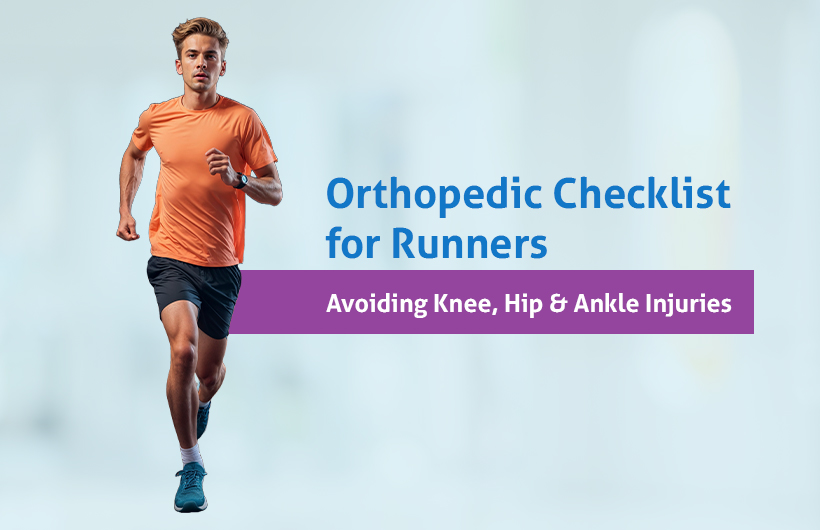Running is one of the most accessible and effective forms of exercise. But it also comes with risks, especially for your joints. Whether you’re a seasoned marathoner or a weekend jogger, protecting your knees, hips, and ankles is essential for long-term performance and injury prevention.
This orthopedic checklist brings together practical, evidence-based orthopedic tips for runners to help you stay pain-free and avoid the most common running injuries seen among athletes in Ahmedabad.
Table of Contents
ToggleWhat Causes Runners to become Injured: The Orthopedic Perspective
A combination of overuse, biomechanical problems, inappropriate running shoes, or a lack of warm-ups is likely to result in running injuries. The residency-most common problems orthopedic doctors encounter:
- Jogging induced knee aches
- Hip inflexibility or snapping
- Sprains or tendonitis of the ankle
- Stress fractures, shin splints
Such injuries are not only setbacks to your development but also may turn out to be chronic issues when not treated.
Orthopedic Tips for Runners: The Must-Do Checklist
1. Prioritize Proper Footwear
Wearing the right shoes is your first defence against injury.
- Visit a professional to analyse your gait
- Choose running shoes with ample heel support and shock absorption
- Replace shoes every 500–800 km
- Avoid running in worn-out or unevenly worn shoes
Poor footwear alignment directly increases the risk of ankle sprains and knee pain post-run.
2. Warm-Up Like You Mean It
A cold muscle is a tight muscle, and tightness leads to injuries.
Do this before every run:
- 5–10 minutes brisk walking or slow jogging
- Dynamic stretches like leg swings, lunges and hip openers
- Avoid static stretches before running; save them for after
Dynamic warm-ups increase blood flow and prep the joints, especially your hips and ankles, for impact.
3. Follow a Structured Training Plan
Avoid the temptation to go too far, too fast.
- Do not overdo it, boost weekly mileage by no more than 10%
- Include recovery days in your schedule
- Add cross-training (such as swimming or biking) to minimize repetitive stress
- You should emphasize quality rather than quantity-intervals and tempo runs will develop the stamina more than junk miles
Sharp surges in training are the biggest source of sports injuries observed by orthopaedic physicians in runners of Ahmedabad.
4. Build a stronger support system.
Running is a whole-body activity and not a leg activity. Compensatory mechanisms give rise to pain as a result of a weak muscle.
Do this by targeting the following areas:
- Glutes: Clamshells, bridges and single-legged dead lifts
- Planks, side planks, bird-dogs -core
- Hip stabilizers: lateral band walks, monster walks
- Ankles: Resistance band mobility exercises, balance exercises, calf raises
Strength increases stability, joint control, and most importantly, knee alignment and ankle tracking.
5. Never Break-Up Pain
Pain is feedback. Hear it.
- Severe/Acute pain? Stop immediately.
- Achy pains? Rest and review form.
- Swelling or bruising? Seek medical evaluation.
According to the orthopedic specialists, it is advisable that such injuries be tackled at an early stage to prevent chronic injuries and promote faster recovery time.
6. Maintain Flexibility & Mobility
Muscle tension causes stress on joints.
Research these stretches after a run:
- Hamstring stretch
- Stretching of quads
- Calf stretch
- IT band and Hip flexor stretches
Exercise foam roller and mobility balls can release trigger points, particularly in the hips and knees.
7. Orthopedic Evaluation-Get evaluated when you are struggling
In case you constantly feel knee pain after jogging or have any other persistent discomfort, a visit to a modern orthopedic hospital in Ahmedabad is not only advisable, but obligatory.
A tailored evaluation will be able to:
- Pick up gait biomechanical weaknesses
- Prescribe special orthotics or physiotherapy
- Help avoid the development of small problems
Common Running Injuries Orthopedic Doctors See
Here’s a quick snapshot of running injuries that can be avoided with the right running injury prevention strategies:
| Injury | Symptom | Cause |
| Runner’s Knee (Patellofemoral Pain) | Pain around the kneecap during/after runs | Poor tracking, weak quads/glutes |
| Shin Splints | Pain along inner shinbone | Overuse, hard surfaces |
| Achilles Tendonitis | Heel and lower calf pain | Tight calves, sudden training load |
| IT Band Syndrome | Pain on outer knee | Tight IT band, hip weakness |
| Hip Bursitis | Outer hip pain | Repetitive motion, poor mechanics |
When to See a Specialist
Don’t wait for pain to become a pattern. Early orthopedic consultation ensures faster recovery and long-term joint health.
Consult a sports injury specialist in Ahmedabad if you experience:
- Persistent knee or hip pain
- Swelling or bruising after a run
- A popping sound followed by pain
- Limited range of motion
- Pain lasting more than 2–3 days, even with rest
Why Runners in Ahmedabad Trust Dr. Hardik Padhiyar
Dr. Hardik Padhiyar, a senior orthopedic surgeon in Ahmedabad, specializes in sports injuries, joint preservation, and musculoskeletal health. His approach blends precise diagnosis, advanced imaging, and tailored rehabilitation.
Runners trust him for:
- Accurate diagnosis of running injuries
- Non-invasive treatment-first approach
- Expert guidance on orthopedic tips for runners, strength training, and recovery
His clinic is regarded as one of the best orthopedic clinic near you in Ahmedabad, serving both professional athletes and recreational runners.
Final Word: Run Smart, Run Long
Injury-free running isn’t luck—it’s preparation. Following these orthopedic tips for runners ensures stronger joints, faster recovery, and better performance.
If pain persists, don’t wait. Book a consultation with Dr. Hardik Padhiyar, an experienced orthopedic expert in Ahmedabad, and get back on track safely.
Your best run begins with healthy joints.






